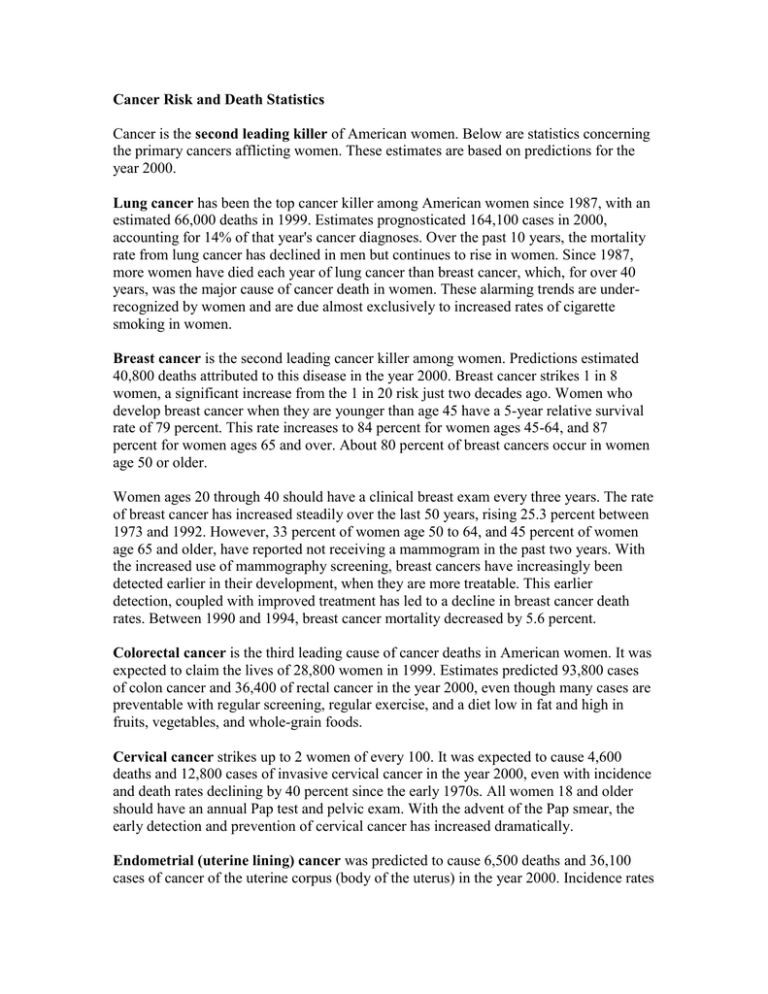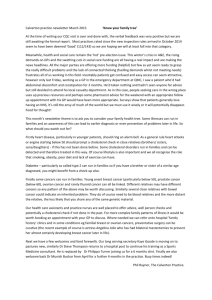Cancer Risk and Death Statistics second leading killer
advertisement

Cancer Risk and Death Statistics Cancer is the second leading killer of American women. Below are statistics concerning the primary cancers afflicting women. These estimates are based on predictions for the year 2000. Lung cancer has been the top cancer killer among American women since 1987, with an estimated 66,000 deaths in 1999. Estimates prognosticated 164,100 cases in 2000, accounting for 14% of that year's cancer diagnoses. Over the past 10 years, the mortality rate from lung cancer has declined in men but continues to rise in women. Since 1987, more women have died each year of lung cancer than breast cancer, which, for over 40 years, was the major cause of cancer death in women. These alarming trends are underrecognized by women and are due almost exclusively to increased rates of cigarette smoking in women. Breast cancer is the second leading cancer killer among women. Predictions estimated 40,800 deaths attributed to this disease in the year 2000. Breast cancer strikes 1 in 8 women, a significant increase from the 1 in 20 risk just two decades ago. Women who develop breast cancer when they are younger than age 45 have a 5-year relative survival rate of 79 percent. This rate increases to 84 percent for women ages 45-64, and 87 percent for women ages 65 and over. About 80 percent of breast cancers occur in women age 50 or older. Women ages 20 through 40 should have a clinical breast exam every three years. The rate of breast cancer has increased steadily over the last 50 years, rising 25.3 percent between 1973 and 1992. However, 33 percent of women age 50 to 64, and 45 percent of women age 65 and older, have reported not receiving a mammogram in the past two years. With the increased use of mammography screening, breast cancers have increasingly been detected earlier in their development, when they are more treatable. This earlier detection, coupled with improved treatment has led to a decline in breast cancer death rates. Between 1990 and 1994, breast cancer mortality decreased by 5.6 percent. Colorectal cancer is the third leading cause of cancer deaths in American women. It was expected to claim the lives of 28,800 women in 1999. Estimates predicted 93,800 cases of colon cancer and 36,400 of rectal cancer in the year 2000, even though many cases are preventable with regular screening, regular exercise, and a diet low in fat and high in fruits, vegetables, and whole-grain foods. Cervical cancer strikes up to 2 women of every 100. It was expected to cause 4,600 deaths and 12,800 cases of invasive cervical cancer in the year 2000, even with incidence and death rates declining by 40 percent since the early 1970s. All women 18 and older should have an annual Pap test and pelvic exam. With the advent of the Pap smear, the early detection and prevention of cervical cancer has increased dramatically. Endometrial (uterine lining) cancer was predicted to cause 6,500 deaths and 36,100 cases of cancer of the uterine corpus (body of the uterus) in the year 2000. Incidence rates for endometrial cancer were higher among white women (22.4 per 100,000) than among black women (15.3 per 100,000). Ovarian cancer is the most deadly of the cancers of the female reproductive system because symptoms often appear only in the advanced stages of the disease. In 1999, there were over 14,500 deaths and nearly 25,200 ovarian cancer cases. Estimates predicted improvements to 14,000 deaths and 23,100 new cases in the year 2000. Ovarian cancer is the second greatest gynecological cancer, comprising 4 percent of women's cancer cases. Skin Cancer caused an estimated 9,600 deaths in the year 2000. Approximately 1.3 million cases of highly curable basal cell or squamous cell cancers develop annually. The prevalence of melanoma, the most serious form of skin cancer, has doubled since 1973 from 6 cases per 100,000 people to 12 per 100,000. For the year 2000, estimates predicted 47,700 cases of this form of skin cancer. Skin cancer is more common among individuals with lightly pigmented skin. Although men are generally more susceptible to skin cancer, women under the age of 40 comprise the fastest growing group of skin cancer patients. Adapted from American Cancer Society "Cancer Facts and Figures 2000" (http://www.cancer.org)



